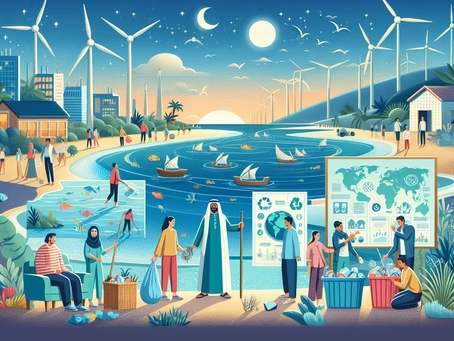Introduction
The health of our oceans is critical to the well-being of coastal communities and the planet at large. Empowering these communities to manage their marine resources sustainably is not just a matter of environmental stewardship; it is a vital component of global efforts to combat climate change, preserve biodiversity, and support economic resilience. This article explores the many approaches to sustainable ocean management, highlighting community-led initiatives, education, collaborative governance, economic sustainability, technological innovation, legal frameworks, carbon sequestration, and partnerships in fostering harmony between people and the sea.
Key Takeaways
- Community-led initiatives are essential for effective and sustainable ocean management.
- Education and awareness foster ocean literacy and leverage traditional knowledge.
- Collaborative governance ensures inclusive, equitable, and impactful ocean policies.
- Sustainable economic practices protect ecosystems while supporting livelihoods.
- Technology, legal frameworks, and partnerships strengthen marine conservation efforts.
Community-Led Initiatives
Grassroots Movements
Local action drives sustainable ocean management. Grassroots movements are tackling pollution, reviving traditional fishing, and creating patrols to safeguard marine habitats. These efforts prove that when communities lead, the results are lasting and meaningful.
Case Studies
- Philippines: Coral reef revival through strict fishing regulations.
- Belize: Community-managed reserves boosting both ecosystems and livelihoods.
- Palau: Sustainable tourism balancing visitors with environmental protection.
- Norway: Traditional knowledge guiding eco-friendly aquaculture.
These examples serve as blueprints for others, inspiring a ripple effect of stewardship worldwide.
Global Networks
Connecting communities amplifies impact. Through conferences, online forums, and collaborations, local guardians share solutions, celebrate achievements, and strengthen conservation worldwide.
Education and Awareness
Schools as Hubs of Change
Schools can shape ocean stewards by teaching conservation, promoting participation in cleanups, and integrating sustainability across subjects. Young learners grow into future leaders who carry this knowledge forward.
Public Workshops
Workshops bring marine science to life, raising awareness about pollution, sustainable seafood, and ecosystem health. Ocean literacy transforms citizens into active protectors.
Traditional Knowledge
Indigenous wisdom emphasizes respect, balance, and sustainability. Integrating these practices with modern science creates culturally relevant and effective strategies for marine conservation.
Collaborative Governance
Inclusive Decision-Making
Inclusive governance ensures diverse voices—from fishers to elders—are heard in policymaking. This strengthens resilience and equity in ocean management.
Balancing Local and Global Goals
Effective strategies align community needs with international sustainability objectives. Dialogue and integration create solutions that benefit both people and the planet.
The Role of NGOs
NGOs bridge local communities and policymakers by offering expertise, advocacy, and capacity building. Their work empowers communities to protect and manage marine environments effectively.
Sustainable Livelihoods
Eco-Tourism
Eco-tourism generates income while promoting environmental education and conservation. Profits often support local projects, creating a cycle of protection and prosperity.
Sustainable Fishing
Catch limits, selective gear, and no-take zones prevent overfishing and protect biodiversity. Eco-labeling empowers consumers to choose responsibly sourced seafood.
Innovative Business Models
Blue bonds, social enterprises, and technology-driven ventures are creating profitable yet sustainable economic pathways for ocean stewardship.
Innovation and Technology
GIS and Remote Sensing
High-tech mapping and monitoring help communities track reef health, detect illegal fishing, and study climate impacts.
Recycling Ocean Plastics
Turning waste into products supports a circular economy, cleans seas, and creates jobs.
Renewable Marine Energy
Wave, tidal, and thermal energy systems reduce carbon emissions while powering coastal communities sustainably.
Legal Frameworks
Community Rights
Legal recognition empowers communities to manage resources and safeguard traditions while ensuring resilience against environmental threats.
Marine Protected Areas
Effective MPAs require enforcement through patrols, technology, and local involvement to move beyond “paper parks.”
International Laws
Global conventions shape local practice. Tailoring policies to community needs ensures both compliance and equity.
Blue Carbon
Coastal Ecosystem Value
Mangroves, seagrasses, and salt marshes store carbon, protect coasts, and support biodiversity.
Restoration Projects
Restoring habitats strengthens resilience, enhances biodiversity, and supports local economies while fighting climate change.
Carbon Credits
Valuing stored carbon creates financial incentives for communities to conserve ecosystems, aligning economics with stewardship.
Partnerships and Collaboration
Cross-Sector Alliances
NGOs, businesses, governments, and researchers pool resources to expand conservation impact and innovation.
Engaging Indigenous Communities
Recognizing indigenous rights and integrating their ecological knowledge leads to more inclusive and effective ocean management.
Global Networks
International collaboration fosters resource sharing, joint initiatives, and advocacy for stronger global marine policies.
Conclusion
Coastal communities, empowered with education, rights, technology, and partnerships, can lead global ocean stewardship. Their success ensures sustainable seas, resilient economies, and a balanced relationship between humanity and the marine environment.

